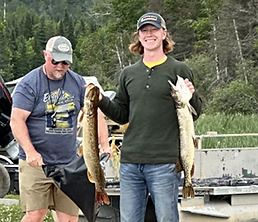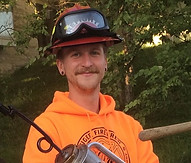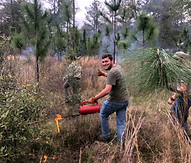
University of Missouri - School of Natural Resources
Silviculture and Restoration Ecology
Silviculture and Restoration Ecology
Dr. Benjamin Knapp (He/Him)
Ben pursued forestry throughout his education, receiving his BS degree from Purdue University in 2003, his MS degree from Clemson University in 2005, and his PhD from Clemson in 2012. He has been a faculty member at University of Missouri since 2012, the Faculty Manager of the Baskett Forest since 2015, and the interim Director of the University of Missouri Center for Agroforestry from 2023-2024. Through understanding ecological processes, his research seeks to refine silvicultural practices to address contemporary issues, often related to restoration or conservation objectives. Specific research topics include tree regeneration, fire ecology and the use of prescribed burning as a silvicultural tool, and understanding how disturbances, through management or natural, affect stand dynamics. He enjoys spending time on outdoor projects at home and exploring new ecosystems by hiking and camping with his family.

Post-doctoral researchers
David Woodbury

David holds a Bachelor of Science degree in Environmental Science and Terrestrial Resource Management from the University of Washington. He also earned both his master's and PhD degrees from Yale University, where he conducted research on various projects. These included studying the effects of land use history and tropical forest fragmentation on tree biomass and composition in South Asia, mine restoration in Kalimantan, Indonesia, and forest dynamics in canopy gaps in Connecticut, among others. Currently, David is working on a project within the Missouri Ozark Forest Ecosystem Project, utilizing dendrochronology data, including stem reconstructions and ring width measurements, to assess the growth of white oak following uneven-aged silviculture.
Doctoral students
Raelin Kronenberg (She/Her)

Raelin has a broad background in biology, environmental science, and natural resources research. Her current work focuses on how forest management practices, including prescribed fire and thinning, affect the establishment and productivity of forest farming systems to grow native woodland botanicals. This research was developed in collaboration with Dr. Sougata Bardhan at Lincoln University to advance our understanding of how to sustainably cultivate high-value nontimber projects. Before pursuing her doctorate, Raelin earned her master's degree in Natural Resources with an agroforestry emphasis from the University of Missouri in 2022. Her previous research explored landowner perceptions of agroforestry for conservation and production. Outside of work, Raelin enjoys hiking with her dogs, learning about plants, horseback riding, and tending her backyard flock of chickens.
Master of Science students
Helena Fairchild

Helena, a Missouri native, is pursuing a master’s degree in Natural Resources with an emphasis in Forestry. Her research focuses on how long-term, frequent prescribed fire affects the abundance and composition of regeneration across site types in the Missouri Ozarks. In the future, she would like to be involved in fuels management or fire ecology. Helena received her BS in Environmental Sciences from the University of Missouri in 2023. She then spent two summers fighting fire on an engine in eastern Oregon, and a winter setting fires on a prescribed fire crew in the Missouri Ozarks (which included burning her future study site). Outside of work, Helena enjoys to run, hike, and see new things.
Karen “Ren” Klug (She/Her)

Karen “Ren” Klug is pursuing a master’s degree in Natural Resources with an emphasis in Agroforestry. Her thesis is focused on maple syrup production in Missouri, with research taking place within the Baskett Research Forest. Following her masters, she is interested in working within the agroforestry industry as a consultant in the Northeast. Ren gained an interest in agroforestry topics following several work exchange programs on small-scale eco-farms during her undergraduate program. She received her bachelor’s degree in environmental science from the University of Nebraska at Omaha. Prior to beginning her master’s, Ren worked throughout Pennsylvania at orchards and in natural resources consulting. Beyond the lab, Ren enjoys painting, traveling, and coffee drinking.
Jake Vitale

Jake Vitale is a graduate student pursuing a master's degree in Natural Resources, with an emphasis in Forestry. His thesis project focuses on characterizing shortleaf pine-oak old growth forests in the Ozark Mountains of Missouri and the Ouachita Mountains of Arkansas. The goal with his project is to collect baseline stand structure measurements of this forest type and to compare stand structure across spatial grains. Jake is originally from upstate New York, where he received his bachelor's degree in Conservation Biology at the State University of New York College of Environmental Science and Forestry (SUNY ESF) in Syracuse, NY. After he received his bachelor's degree and before attending Mizzou for graduate school, Jake experienced multiple field seasons throughout the Northeast, focusing on forest health monitoring, rare alpine plant monitoring, and recreational impacts on forest conditions. During downtime, Jake enjoys hiking, playing guitar, cooking, playing basketball, and canoe camping.
Undergraduate research
Elijah Hanson

From the Show Me state of Missouri, Elijah Hanson is an undergrad student pursuing his degree in Natural Resources Science and Management from The University of Missouri - Columbia. He is analyzing the last 55 years of forest carbon data from Baskett Forest. He has aspirations for future work in carbon dynamics, particularly looking at the impacts of forest management and silvicultural practices on the potential to increase the capacity for carbon storage. He dreams of one day becoming a professor so that he may be able to instill the same joys and passions in future generations that his professors have done for him while still allowing for the continued pursuit of knowledge. Beyond school, he has an undying passion for the culinary arts stemming from high school culinary competitions in which he placed top ten nationally, lives for the crack, thud, and silence of a felled tree, and can't help himself when he comes upon a good body of water.
Research staff
Abby Huffman (She/Her)

Abby is a research specialist for the Silviculture and Restoration Ecology lab. She received a bachelor’s degree in biology and environmental studies from Augustana College before attending the University of Missouri to obtain a master’s degree in forestry. During her time as a graduate student, she studied white oak regeneration at the Baskett Research Forest. Abby has since transitioned to the role of research specialist where she continues to study silviculture for oak regeneration and explores new areas of study like quantitative wood anatomy. While not at work, Abby frequents the movie theater to eat popcorn and watch the latest flicks.
Past members
Drew Anderson - Research staff through 2025
Hailing from Des Moines, IA, Drew Anderson was a research technician at Baskett Forest. Drew began working with Dr. Jeff Wood at the Baskett MOFLUX tower as an undergrad. After graduating with a BS in Forestry from the University of Missouri Columbia, Drew took over the position of Research Specialist in the spring of 2020. He oversaw maintenance and community outreach at Baskett, as well as worked with students and faculty to implement and conduct research projects. Drew is an outdoorsman and spends his time backpacking and climbing. He is also a musician and played in several local Columbia bands.

Dr. Kendra Esparza-Harris - Ph.D. in May 2025
Kendra graduated from North Carolina Agricultural and Technical State University in 2013 with a bachelor’s degree in animal science. She continued her education at the University of Illinois at Urbana-Champaign where she received a master’s degree in animal sciences with a focus in applied reproductive physiology. Following graduation, she became an Agroforestry Extension Specialist with Peace Corps Senegal, where she disseminated improved agroforestry technologies and techniques. At University of Missouri, she was a USDA NIFA National Needs Doctoral Fellow in the Center for Agroforestry, focusing on domestic and international applications of silvopasture. Outside of academic pursuits, Kendra enjoys traveling, playing sports, outdoor-related activities such as hiking, and spending time with her dogs.

Ian Goldberg - M.S. in December 2024
Ian grew up exploring the Pine Barrens and back bay coastal salt marshes of central New Jersey. He earned his B.S. degree in environmental science with a forestry concentration in 2022 through Stockton University. With the University of Missouri, Ian completed a master’s degree in collaboration with the Jones Center at Ichauway in southwest Georgia to identify the age demographics and growth dynamics of longleaf pine sapling patches. His academic interests include fire ecology, silviculture, paleoecology, nursery production, and ornithology. Ian’s hobbies outside of work include birdwatching, painting, gardening, and wildlife photography.

Dr. Isaac Hayford – Ph.D. in August 2023
Isaac grew up in eastern part of Ghana and received his Bachelor’s degree in Forestry from Kwame Nkrumah University of Science and Technology in June 2010. He obtained his master’s degree in Forestry from Michigan State University in August 2017 as a Mastercard Foundation Scholar. His master’s thesis focused on the impact of climate (climate moisture index and temperature) on the growth of oak and other competitor species such as red maple and black cherry in Michigan. In 2023, he completed his doctorate in Natural Resources with Forestry Emphasis at University of Missouri, Columbia, working on ecology and management of oak regeneration (natural and artificial) in bottomland hardwood forests in Missouri. Prior to graduate school in Missouri, he worked with Forestry Commission of Ghana as a Forest Range Manager. In his spare time, Isaac likes watching or playing soccer and enjoys staying outdoors with his family and friends.
Jacob Grochowski – M.S. in August 2023
Jacob grew up exploring the mixed conifer swamps of northeast Michigan. He graduated from the University of Michigan in 2017 with a degree in environmental sciences, focusing on policy and forest ecology. Before coming to Mizzou, he worked with the Michigan DNR, Cumberland Gap National Historical Park, and West Michigan Cooperative Invasive Species Management Area. Most of his work has focused on invasive plant and insect management, especially the management of hemlock woolly adelgid. He pursued master's of science at Mizzou in partnership with Boggy Slough Conservation Area in east Texas as the first Buddy Temple Graduate Fellow. There he studied the competitive dynamics between desired species including upland oaks, shortleaf, longleaf, and loblolly pine and competitors including yaupon holly, sweetgum, and Chinese tallow.
Dr. Hope Fillingim – Ph.D. in May 2023
Hope graduated from Bryn Mawr College in 2011 with a bachelor’s degree in biology. She then got a master’s degree from Villanova University, where she studied the effects of oil sands mining on peatlands in Alberta, Canada. She continued working at Villanova for a few years as a research technician, and then spent a few years working on various small farms, including an apple orchard specializing in rare varieties. She spent a year in Virginia with the Department of Conservation and Recreation, and in 2023 she completed her PhD at the University of Missouri studying shortleaf pine regeneration.



Dr. Lance Vickers – Post-doc 2022
Lance is a native of south Arkansas’ piney woods and bottomland hardwood forests. He earned a BS in Forestry from the Univ. of AR-Monticello in 2006 and worked for a local consulting firm before leaving the flatland to explore Appalachia. He earned an MS degree from Virginia Tech by 2009 and then pursued a Ph.D. in quantitative silviculture from the University of Missouri, completing his degree in 2015. His dissertation developed models and analytical tools to quantify and interpret regeneration and early stand dynamics of Ozark forests. Lance now works as a Sr. Research Specialist to develop broad-scale regeneration evaluation analytics for 24 northern states using national forest inventory data. He also is a lead scientist for “Operation Ponderosa” – a collaborative effort to develop regeneration methods for ponderosa pine restoration in the Davis Mountains of west Texas. Outside of work, Lance enjoys exploring the world on family adventures and hopes to one day complete the family National Park passport stamp collection.
Trystan Harpold – M.S. in August 2022
Trystan grew up on the high plains of eastern New Mexico. He earned his bachelor’s degrees in Conservation Ecology and French Language from New Mexico State University in 2019. While there, he completed research with the NMSU herbaria on the use of invasive species in urban forestry and worked as a student research technician. In 2020, he moved from the deserts of southern New Mexico to the forests of central Missouri to pursue a master’s degree in forestry at the University of Missouri. In 2022, he completed his master’s thesis focusing on understanding oak regeneration and recruitment in the Missouri Ozarks under uneven-aged management. In his free time, Trystan in an avid outdoorsman who enjoys hunting, fishing, hiking, and beer brewing.


George Jensen – M.S. in August 2022
George Jensen, originally from Wisconsin, is a graduate student working in collaboration with researchers from The Jones Center at Ichauway, where his project has two main focuses. Firstly, on how regeneration domes of longleaf pine influence fire behavior and secondly on how climate adaptive silviculture treatments handle higher intensity wildland fire. George graduated from the University of Wisconsin, Stevens Point with a BS in Wildland Fire Science. He previously worked for the federal government as a wildland fire fighter in Montana and Wyoming, the State of Wisconsin as a Conservation Biologist for the Endangered Resources section of the WNDR, and for the private sector as a habitat specialist. George loves learning about how ecosystems are developed and working with the public to better educate on matters of wildfire, prairie establishment, and pollinator ecology.

Dacoda Maddox – M.S. in August 2022
Dacoda grew up in Kansas City, Missouri. He spent 8 years in the Marine Corps and exited the service in 2014. After the service he knew he could not work inside and decided to go to school to be a conservation agent at Missouri State University. During his second semester he took his first forestry class quickly gained a passion for forestry. Dacoda founded Missouri State's first forestry club and took its first team ever to conclave. He graduated Missouri State with a bachelors in natural resources and minors in forestry and agronomy. Shortly after graduation he landed a job doing timber stand improvement and eventually lucked into a job as a research technician for the US Forest Service, where he is currently employed. His Masters research focused on savanna restoration in restored prairies and woodland restoration focusing on ground flora.

Justin Dee - Post-doc 2019
Justin is from central Florida, earning his Bachelor of Science degree in Biology from Florida Atlantic University in 2010. After graduating from Oklahoma State University in 2017 with his doctorate, Justin joined Dr. Michael Stambaugh and the Missouri Tree-Ring Lab at Mizzou as postdoctoral researcher. Justin worked with Dr. Knapp on a large data set from the Missouri Ozark Forest Ecosystem Project (MOFEP) to investigate how, through time, different silvicultural practices (such as clearcutting or single tree selection) affect the composition of the woody and herbaceous ground flora within different ecological land types. He currently works as a Assistant Professor of Biology at Stetson University.

Shunzhong Wang - Visiting Scholar 2019
Dr. Wang earned a Ph.D. in Ecology from the Institute of Applied Ecology, Chinese Academy of Sciences in 2006, foscusing on forest vegetation patterns in secondary forest zones. He now works as an engineer to monitor soil and water change in Donglingshan Ecosystem Research Station, Institute of Botany, Chinese Academy of Sciences. Dr. Wang is interested in various aspects of forest ecology, with particular emphasis on the role of environment and species composition on forest carbon in temperate forest ecosystems. He will be visiting the lab through December 2019.

Connor Crouch - M.S. in August 2019
Connor grew up in Downers Grove, IL, a Chicago suburb founded on a grove of oak trees. He graduated from the University of Missouri with a Bachelor of Journalism degree, but not before realizing his interest in forestry rivaled his passion for writing. After cramming in some last-minute forestry credits, Connor joined Dr. Knapp’s lab, where he has had the chance to study the longer-term effects of site preparation treatments on longleaf pine stand development and on the surrounding vegetation.
Muhamad Nugraha - M.S. in August 2019
Huda grew up in western part of Java island, Indonesia and received his Bachelor’s degree in Plant Protection from Bogor Agricultural University in September 2013. He worked for an industrial timber plantation company in Sumatera and Borneo Island, Indonesia, under Department of Research and Development, focusing on Forest Pest & Disease. Supported by USAID-PRESTASI and Center for Agroforestry, he left his family back at home to continue his study to M.S. at School of Natural Resources, University of Missouri, under supervision of Dr. Benjamin O. Knapp & Prof. Rose-Marie Muzika. MIZ-ZOU.


Guerric Good - M.S. in May 2019
Guerric was born and raised in Terre Haute, IN. He completed a Bachelors of Science degree in Natural Resources from Ball State University in December 2012. After graduation, his interest in forestry took him from Indiana to Montana where he worked in timber stand improvement as a seasonal technician for the United States Forest Service. At the University of Missouri, Guerric is working toward a Masters of Science pursuing a better understanding of group openings and oak regeneration in the Missouri Ozarks.

Mary Wachuta - M.S. in December 2018
Mary grew up in southwestern Wisconsin and received her Bachelor’s degree in Forestry and Applied Ecology and Environmental Science from Michigan Technological University in April 2016. Her Master’s of Science at the University of Missouri was a joint project with Clemson University and the US Forest Service to create a fire mortality model for eastern hardwood species that can be incorporated into the First Order Fire Effects Model (FOFEM).

Patrick Curtin - M.S. in December 2017
Pat is a Massachusetts native, with a Bachelors of Science degree in Biology from Bridgewater State University. After completing his degree, Pat worked several seasons as a forestry and wildlife technician, traveling from the Pine Barrens of Long Island, to the spruce-fir forests of Maine, and then to the longleaf pine savannas of Georgia. His research was a collaboration between the University of Missouri and the Joseph W. Jones Ecological Research Center, examining canopy recruitment dynamics in naturally regenerated longleaf pine woodlands.

Samantha Anderson - M.S. in May 2017
As a New Jersey native, Sam had never been west of the Mississippi River. After graduating from The Richard Stockton College of NJ with a Bachelor’s of Science in Environmental Science, she worked for a year with the New Jersey Forest Service. She then traveled to Puerto Rico for three months as a field technician to study growth and mortality in a tropical dry forest. Shortly after returning home she headed out to Missouri to begin her Master’s in Forestry, studying carbon dynamics in shortleaf pine forests.

Casey Ghilardi - M.S. in December 2016
Casey is a New Jersey native with a degree in environmental science from Stockton College. After graduating, he joined the working world at the technician level working westward from the Pine Barrens of New Jersey to the hardwood forests of Pennsylvania, then Indiana, and then landed in Missouri. Casey's project used empirical field data to evaluate accuracy of the Fire and Fuels Extension of the Forest Vegetation Simulator in the Missouri Ozarks.

Bob Rives - M.S. in December 2016
Bob is a Missouri native, raised in Chesterfield, MO. He graduated from the University of Missouri-Columbia in May 2014 with a Bachelors of Science degree in Forestry. Bob decided to pursue a Master of Science degree, studying the effectiveness of silvicultural treatments at regenerating oak species in mixed bottomland hardwood forests. His study is partnered with the Missouri Department of Conservation and will give resource foresters challenged with managing mixed bottomland hardwood forests information to better manage these ecosystems.

Calvin Maginel - M.S. in August 2015
Calvin is a Missouri native of Reynolds County, although his educational and work experiences are varied. After graduating from Berea College in Kentucky, he immediately moved to the Pacific Northwest to survey salmon. An endangered warbler in Texas next caught his attention, after which he worked for The Vermont Nature Conservancy as a land steward/volunteer coordinator. An extended visit to Guatemala and a boat building school later, he ended up back at his home state as a botanist. He researched the effects of landscape-scale prescribed burning on Ozark ground flora with data collected on The Nature Conservancy's Chilton Creek Preserve.
